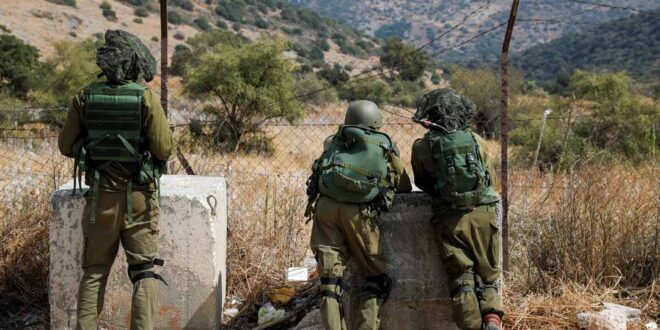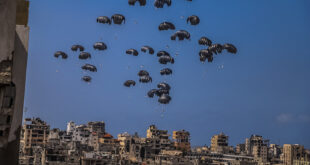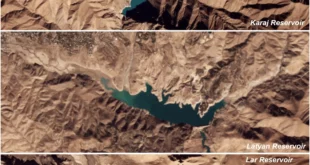Thus far, October’s exchanges of fire between Hizbollah and Israel have stayed within the sides’ red lines. Still, with an Israeli ground invasion of Gaza looming, risks are tremendous. A Gaza ceasefire, while improbable, is the only way to rule out a broader war.
Since 8 October, the second day of the mounting Gaza war, Hizbollah and Israel have traded sporadic fire over the Lebanese-Israeli border. For now, both sides appear keen to stick to the established “rules of the game” – unwritten understandings about red lines neither should cross – to avoid an escalation. Yet things could turn deadly at any moment. Palestinian militants operating from Lebanese soil have already fired rockets at Israel and tried to breach the border, drawing Israeli shelling that has caused casualties, prompting Hizbollah to respond. Should additional clashes take Israeli lives, provoking a massive retaliation, the Shiite Islamist group would be in a very difficult position. Separately, Israeli operations in Gaza may transgress boundaries that induce Hizbollah to enter the fray, turning the Gaza war into a broader Middle Eastern conflict. External actors with Hizbollah’s ear should impress on the party, and Western countries on Israel, that opening a second front is in no one’s interest. Ultimately, the only way to rule out a slide into regional conflagration is a ceasefire in Gaza, however unlikely that appears for now.
” External actors with Hizbollah’s ear should impress on the party, and Western countries on Israel, that opening a second front is in no one’s interest. “
Until now, the exchanges of fire have remained within the bounds that Hizbollah and Israel have set over the years. These loose rules of engagement have emerged not through open discussion but tacitly through many skirmishes between the two sides since their last major conflict in 2006. Wary of repeating that war’s horrors, both have repeatedly gone out of their way to avoid a similar confrontation. Israel reportedly has made efforts to avoid killing Hizbollah operatives by calling them on cell phones to warn of incoming fire. It has allegedly staged casualties among its own troops to convince Hizbollah commandos that they had succeeded in their mission and could withdraw. It has further ignored claims by Israeli and international observers that Palestinian groups firing rockets from Lebanon are Hizbollah proxies. For its part, Hizbollah has sometimes downplayed the severity of Israeli strikes so that it would not feel compelled to hit back; restricted its own attacks and counterattacks to the uninhabited Shebaa Farms, a border area occupied by Israel; resorted to rhetoric in lieu of actual retaliation; and claimed to have received Israeli “apologies” for killings of its fighters that were ostensibly unintentional.
The reason for these sometimes baffling contortions has always been the same: both sides fear that another Lebanon war like the one in 2006 would be highly destructive, with no prospect of a tangible gain that could come close to justifying the cost. In 2006, the toll was steep – in Lebanon, over 1,000 dead, hundreds of thousands displaced and massive physical damage and in Israel, more than a hundred lives lost – and the achievements were meagre. A new war could be much worse. Israel has the military wherewithal to incinerate all of Lebanon, but Hizbollah’s arsenal of several thousand drones and 150,000 missiles is formidable itself. In August, Hizbollah Secretary General Hasan Nasrallah said the party also has a store of precision-guided rockets programmed to hit all the key nodes of Israel’s highly developed infrastructure. It was part of rhetorical jousting in which Israeli Defence Minister Yoav Gallant said Israel would bomb Lebanon back “to the stone age” in another conflict. The point of these statements was clear: each side was admonishing the other not to think of reprising what happened in 2006.
” Events since the beginning of the Gaza war suggest that the pattern of mutual deterrence holds. “
Events since the beginning of the Gaza war suggest that the pattern of mutual deterrence holds. On 8 October, Hizbollah fired a salvo at an Israeli military base in Shebaa Farms, in what the head of Hizbollah’s Executive Council Hashem Safieddine described as a “message of greeting, thanks and appreciation” to Hamas for its lethal attacks in Israel. He also called on Israel to “reflect profoundly on the message of resistance”. A central rule of engagement between Israel and Lebanon is that what happens in Shebaa Farms stays there – that is, it is an accepted arena for exchanges of fire. No one lives there, eliminating the chance of civilian casualties. In this case, furthermore, by delaying its “greeting” for a full 24 hours after the Hamas assault, Hizbollah made reasonably sure that all the Israeli soldiers serving at the base would be sitting well protected in bunkers. So it proved: Israel reported no one hurt.
The next incident was more worrying, but its fallout also appears contained. On 9 October, a series of cross-border infiltration attempts led Israel to fire artillery barrages at nearby areas on the Lebanese side of the frontier. Hizbollah explicitly denied involvement in these attempts, while Palestinian militants claimed some. Israel refrained from accusing Hizbollah of taking part in any of them. But it did shell an observation tower used by Hizbollah fighters, killing three of them – a provocation that the group could well consider a violation of its red lines in certain circumstances.
Afterward, according to a media outlet aligned with Hizbollah, Israel relayed a message to the party, through UNIFIL, the UN peacekeeping mission in southern Lebanon, saying it had thought Hizbollah removed its personnel from border installations. Though impossible to confirm, this claim resembles others that party-affiliated media have made about previous border clashes. If accurate, it would indicate a serious Israeli effort to de-escalate, which Hizbollah would appear to have received well; if not, it shows that Hizbollah is able to craft narratives that allow it to circumscribe its military response without losing face.
Either way, Hizbollah’s response was indeed limited, with strikes on two Israeli bases near the border shortly after nightfall and on Israeli military vehicles the next day. This time, there were casualties, with one Israeli serviceman dead and another injured. With the number of dead and wounded nearly even, both sides apparently decided to consider the altercation over. Importantly, in both cases Hizbollah announced it had used guided missiles, indicating that it was trying to avoid collateral damage. Another infiltration attempt on 13 October once more triggered Israeli artillery fire, with some of the shells hitting a group of journalists, killing one and injuring two. Again, Hizbollah restricted itself to hitting military positions near the border.
” The situation on the border is extremely dangerous. “
Nonetheless, the situation on the border is extremely dangerous. Further infiltrations by Palestinian groups would bring a high risk of escalation. Hizbollah might try to distance itself from such operations, but the group has well-documented ties with Hamas and the Palestinian Islamic Jihad, which have claimed some of the attempted breaches in October to date. During the 2021 Gaza war, the groups created a joint operations room, which allowed the Palestinian groups to benefit from Hizbollah’s intelligence gathering, as well as its logistical and tactical know-how. In early September, Nasrallah met with deputy Hamas leader Saleh Arouri and Palestinian Islamic Jihad leader Ziyad Nakhaleh, vowing mutual support and daily coordination. From a tactical perspective, Israel may view observation towers staffed by Hizbollah operatives as a military threat, at a time when Hizbollah’s close allies are repeatedly trying to infiltrate Israel. From a strategic perspective, if Israel takes down such towers or other Hizbollah installations every time an infiltration attempt occurs, the group may decide that telling its allies to stand down would be in its own best interest.
Rockets fired by Palestinian groups into northern Israel carry another major escalation risk. Unlike Hizbollah, these groups use unguided projectiles, with next to no control of where they might land. In April, a volley of 34 such rockets landed near a shopping centre and a preschool in northern Israel. Mercifully, these facilities were closed for a Jewish holiday, and hotels and restaurants a short distance away – which were fully booked for the same holiday – were spared. Yet such good fortune may run out eventually. Should a rocket hit a sensitive target – say, a kindergarten – the Israeli government would come under intense pressure to retaliate forcefully. In these circumstances, it might well decide to go after what it sees as the enabler, Hizbollah, along with the actual perpetrators. The more projectiles are launched, the higher the probability of disaster.
There is also the danger that Hizbollah itself decides to open a second front. Interlocutors in the party milieu mention two “red lines” that might trigger such a move: one, if Israel were to forcibly displace a significant number of Gaza residents to somewhere outside the enclave – Egypt would appear to be the only plausible destination – and two, if Israel were to move forward with a ground invasion aimed at completely destroying Hamas.
The first red line may soon be put to the test. In the early hours of 13 October, Israel dropped leaflets in Gaza telling the residents of its northern portion, which makes up some 40 per cent of its territory and is home to 1.1 million people, to evacuate and flee south. Such an immense population movement, amid a bombardment and potential ground operation, a blockade stopping any supplies from getting in and a total breakdown of services, is liable to create a humanitarian disaster of massive proportions. Egypt is being asked to open its borders to this new stream of refugees, a request it so far categorically refuses to consider. Hizbollah and its allies may come to view these events as evidence that Israel’s goal Is the expulsion of as many Palestinians as possible. As for the second Hizbollah red line, obliterating Hamas is the official objective of Israel’s war effort – and, at this point, one seemingly underwritten by the U.S.
What, then, should one make of these stated red lines? Signals from Hizbollah that either scenario could lead to war are likely meant to deter Israel from going down this road, as well as to add urgency to mediation efforts going through Qatar. They should, however, not be dismissed as mere rhetoric: Hizbollah and Iran have clearly invested a lot of time and money in boosting the capacities of Hamas, so as to turn it into an effective member of the alliance they have forged, what they call the “axis of resistance”. Losing this investment would be a serious setback and a precedent that both want to avoid setting. Standing down while yet another part of the population of historical Palestine is driven out of the country would make the slogans of the “axis” ring hollow, since the alliance’s ideological agenda is based partly on commitment to the Palestinian cause. It could sap the loyalty of the “axis” members’ political base.
Opening a second front would not necessarily lead straight to the all-out war that Hizbollah and Israel have been trying not to spark since 2006. Rather, Hizbollah might decide to gradually raise the temperature to heighten the conflict’s costs to Israel. It might calculate that Israel, with its hands full in Gaza, would tolerate far more blatant provocations than what have occurred so far to avert a repeat of the 2006 war. Hizbollah has long argued that a full-scale war with Israel is liable to spiral into a regional conflict that no one, not even the U.S., can afford. The party leaders may imagine – rightly or wrongly – that any move in that direction would prompt other powers, including Russia or China, to make more assertive efforts to arrest a further escalation, in the process embarassing Washington.
Such a course would obviously be perilous, but the confidence that Hizbollah has displayed in recent years makes it appear possible that the party could abandon the “rules of the game” and venture into uncharted territory. For now, prospects for de-escalation in Gaza seem slim. While Israel has a right to respond militarily to the Hamas attacks, the most urgent task for those seeking to prevent the situation from deteriorating further is to defend more forcefully the principles of international humanitarian law.
Then, as soon as possible, the only reliable way of stopping the war from triggering a wider regional confrontation would be to strengthen mediation efforts aimed at getting to some form of ceasefire and securing the release of the Israeli hostages and prisoners held by Hamas.
 Eurasia Press & News
Eurasia Press & News



